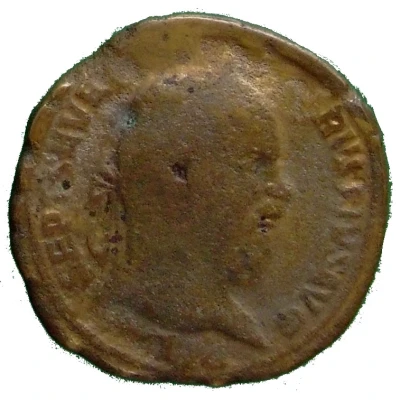


© Institute of Classics/University of Graz
Sestertius - Septimius Severus and Caracalla P M TR P XVII COS III P P S C; Pietas and Concordia
209 year| Bronze | 20.2 g | - |
| Issuer | Rome › Roman Empire (27 BC - 395 AD) |
|---|---|
| Emperor | Septimius Severus (Lucius Septimius Severus) (193-211) |
| Type | Standard circulation coin |
| Year | 209 |
| Value | 1 Sestertius = ¼ Denarius |
| Currency | Denarius, Reform of Augustus (27 BC – AD 215) |
| Composition | Bronze |
| Weight | 20.2 g |
| Shape | Round (irregular) |
| Technique | Hammered |
| Demonetized | Yes |
| Updated | 2024-10-06 |
| Numista | N#270256 |
|---|---|
| Rarity index | 100% |
Reverse
Septimius Severus, veiled, togate, standing left, sacrificing out of patera in right hand over tripod in centre, and holding roll in left hand; before him, on left, Caracalla, veiled, togate, standing right, extending right hand over tripod; behind and between them, Pietas or Concordia (?).
Script: Latin
Lettering: P M TR P XVII COS III P P S C
Translation:
Pontifex Maximus, Tribunicia Potestate Septima Decima, Consul Tertium, Pater Patriae. Senatus Consultum.
High priest, holder of tribunician power for the 17th time, consul for the third time, father of the nation. Decree of the senate.
Comment
Example of this type:Institute of Classics/University of Graz
Source:
Online Coins of the Roman Empire (OCRE)
Interesting fact
One interesting fact about this coin is that it features an image of the Roman goddess Pietas, who represents duty, loyalty, and devotion, on one side, and an image of the Roman goddess Concordia, who represents harmony and unity, on the other side. This coin was minted during the reign of Emperor Septimius Severus and his son Caracalla, who ruled the Roman Empire from 193 to 211 AD. The coin's design highlights the importance of these virtues in Roman society and suggests that the emperors saw themselves as promoting unity and harmony within the empire.